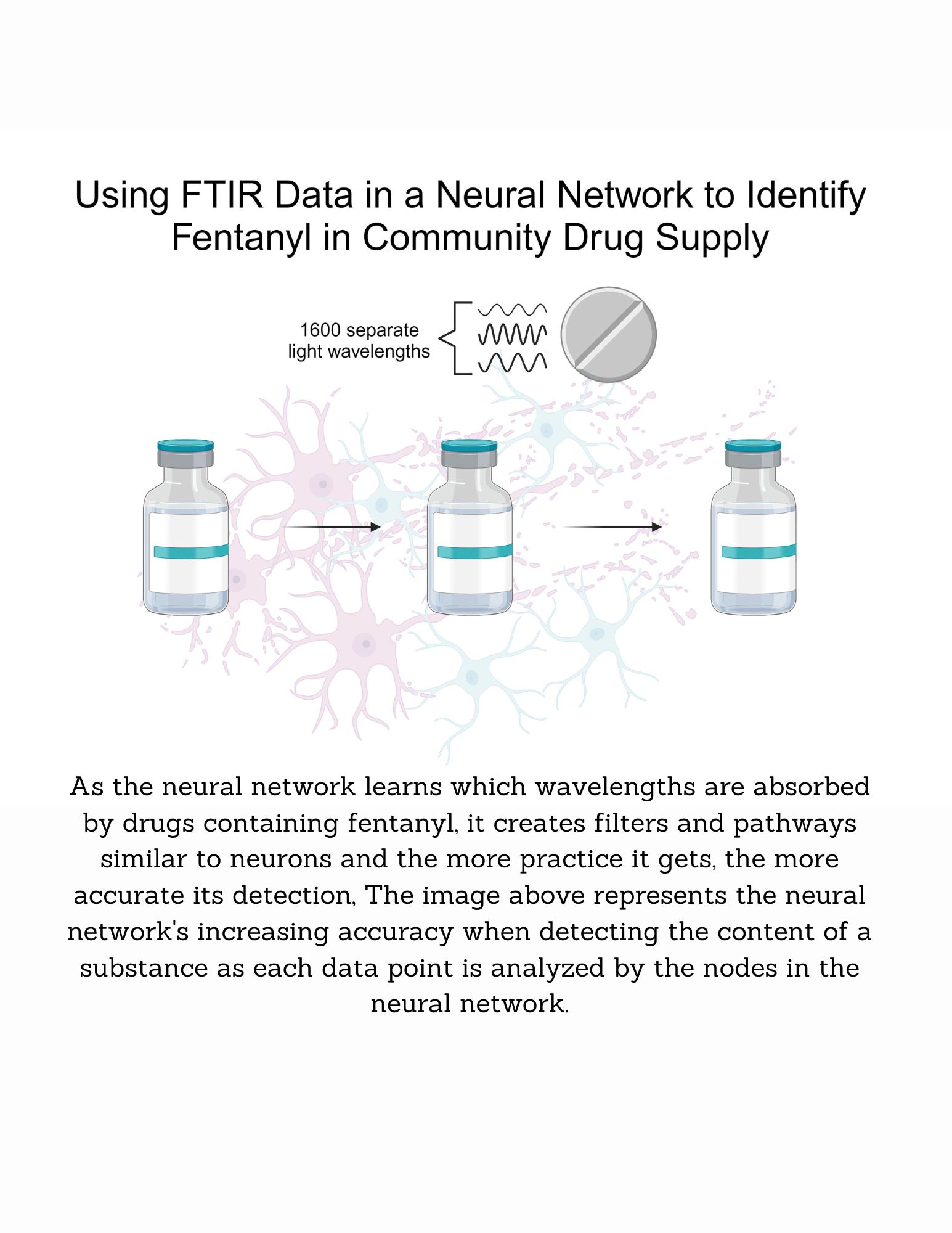“Apache,” “Goodfellas,” “Murder 8,” — Fentanyl goes by several dark names but none of them capture its rap sheet of causing over 150 deaths per day. 50 times stronger than heroin and 100 times stronger than morphine, an overdose can occur with less than 2 milligrams of fentanyl present. In the unregulated illicit drug market, many drugs are laced with much more (CDC, 2023). These alarming statistics coupled with its wide-spread use have led scientists to consider employing neural networks to detect the presence of fentanyl and its analogs. Thanks to recent developments, now we can.
You may be wondering: what is fentanyl and how has it become so widespread despite being known to be so dangerous? Well, fentanyl is a synthetic opioid similar to morphine, often illegally produced (DEA, 2021). It is frequently mixed into other illicit drugs (ex. Heroin, methamphetamine, and cocaine) to make it significantly more potent. But because the unregulated drug market is often not managed as an exact science, lethal doses are frequently present in these drugs without the user’s knowledge, leading to overdoses and almost invariably, death. Therefore, speedy, inexpensive, and highly accurate detection is vital.
With the recent rise in the popularity of artificial intelligence (AI) systems, scientists have begun to consider if high-speed machine learning could provide a solution to this unregulated and unpredictable problem. The neural network system works similarly to the human brain with nodes that function as neurons traveling through various hidden processing layers eventually reaching an output (IBM, What are neural networks?). Within the hidden layers are many nodes (filters), which direct input to other filters, eventually obtaining enough information to identify the presence of fentanyl in a substance. This model for fentanyl testing is exciting because, being that it is a subset of machine learning, it has the unique capability to become increasingly advanced over time.
To determine the presence of fentanyl in a sample, most public health organizations in North America implement a technique called Fourier-transform infrared (FTIR) spectroscopy. FTIR spectroscopy works by exposing a substance to specific wavelengths of light and measuring the amount of absorption, by the substance, of each wavelength. By comparing the absorbed wavelength to those that arise in substances containing fentanyl, FTIR successfully identifies samples containing fentanyl. However, because FTIR can only detect quantities of fentanyl well above the minimum dose that can be lethal, it fails to provide totally accurate results (Ti, 2023). Additionally, FTIR only uses absorption data to test for the presence of fentanyl, ignoring other identifying traits, and further limiting its detection capabilities.
To combat these issues, scientists have attempted to construct a neural network with a decreased detection limit of fentanyl. Today, the standard for accurate detection involves the use of both FTIR and fentanyl immunoassay strips (another type of test for fentanyl) which have a much lower limit of detection. Because of the strips’ high accuracy at nearly 100%, they were used to compare the results of FITR and the neural network machine learning process. The neural network used in this study learns to identify fentanyl in drug samples by testing the substance’s absorption of 1600 different light wavelengths (Ti, 2023). The more samples the neural network was exposed to and corrected, the more accurate it became, eventually having the capability to quickly identify even extremely small quantities of fentanyl in a sample.
When compared to standard FTIR, the results were astounding. The neural network’s overall accuracy was an impressive 96.4% compared to 78.4% by a technician with FTIR, and the neural network avoided false negatives with a recall rate of 97.1% compared to the technician’s dangerously low 64.7% (Ti, 2023). In general, the neural network far outperformed FTIR, leaving scientists considering whether it is time to replace the old tried and true method.
Despite this big break, FTIR tests, when used in tandem with highly accurate fentanyl test strips, are still equally if not more accurate. These tests are successful at identifying fentanyl analogues as well, a feat still not attempted by neural networks (CDC, 2022). Scientists hope to continue experimenting with neural networks and develop automated tests, which could save hundreds of lives. Although fentanyl is putting up a vicious fight, medical technology is turning the tide to take fentanyl down, once and for all.

References:
Centers for Disease Control and Prevention. (2022, September 30). Fentanyl test strips: A harm reduction strategy. Centers for Disease Control and Prevention. https://www.cdc.gov/stopoverdose/fentanyl/fentanyl-test-strips.html
Centers for Disease Control and Prevention. (2023, June 27). Fentanyl facts. Centers for Disease Control and Prevention. https://www.cdc.gov/stopoverdose/fentanyl
DEA. 29 April, 2021. Facts about Fentanyl. Retrieved from https://www.dea.gov/resources/facts-about-fentanyl on 7 August, 2023
Ti, L., Grant, C. J., Tobias, S., Hore, D. K., Laing, R., & Marshall, B. D. (2023). Development of a neural network model to predict the presence of fentanyl in community drug samples. PLOS ONE, 18(7). https://doi.org/10.1371/journal.pone.0288656
What are neural networks?. IBM. (n.d.). https://www.ibm.com/topics/neural-networks
